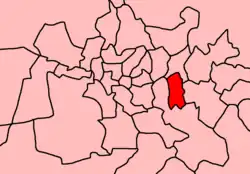Germiston (House of Assembly of South Africa constituency)
| Germiston | |
|---|---|
| Former constituency for the South African House of Assembly | |
 Location of Germiston within the Witwatersrand (1981) | |
| Province | Transvaal |
| Electorate | 20,452 (1989) |
| Former constituency | |
| Created | 1910 1943 |
| Abolished | 1938 1994 |
| Number of members | 1 |
| Last MHA | Derek Christophers (NP) |
| Created from | Germiston North Germiston South (1943) |
| Replaced by | Germiston North Germiston South (1938) Gauteng (1994) |
Germiston was a constituency in the Transvaal Province of South Africa, which existed from 1910 to 1994 with the exception of the 1938 general election. It covered a part of the East Rand centred on the town of Germiston. Throughout its existence it elected one member to the House of Assembly and one to the Transvaal Provincial Council.
Franchise notes
When the Union of South Africa was formed in 1910, the electoral qualifications in use in each pre-existing colony were kept in place. In the Transvaal Colony, and its predecessor the South African Republic, the vote was restricted to white men, and as such, elections in the Transvaal Province were held on a whites-only franchise from the beginning. The franchise was also restricted by property and education qualifications until the 1933 general election, following the passage of the Women's Enfranchisement Act, 1930 and the Franchise Laws Amendment Act, 1931. From then on, the franchise was given to all white citizens aged 21 or over. Non-whites remained disenfranchised until the end of apartheid and the introduction of universal suffrage in 1994.[1]
History
The mines of the Witwatersrand were an early stronghold of South African trade unionism, and this made Germiston fertile ground for the Labour Party. While less safe than seats like Benoni or Jeppes, the party held Germiston during its nationwide peaks in 1920 and 1924-29. Germiston's Labour MP, George Brown, died in office in 1932, and the resulting by-election was won by a young J. G. N. Strauss, later leader of the opposition. In 1938, Germiston was split into a North and a South seat, which were rearranged after just one five-year term into a town and a district seat - Strauss chose to represent Germiston District, and Germiston reverted to Labour for one term before falling to the Herenigde Nasionale Party in 1948.
In its second iteration, Germiston was a safe seat for the governing National Party. Its longest-serving MP, Willem Adriaan Cruywagen, was a cabinet minister under Verwoerd and Vorster, and was later appointed Administrator of the Transvaal.
Members
| Election | Member | Party | |
|---|---|---|---|
| 1910 | F. D. P. Chaplin | Unionist | |
| 1915 | D. F. Drew | ||
| 1920 | George Brown | Labour | |
| 1921 | H. S. McAlister | South African | |
| 1924 | George Brown | Labour | |
| 1929 | |||
| 1932 by | J. G. N. Strauss | South African | |
| 1933 | |||
| 1934 | United | ||
| 1938 | Constituency abolished | ||
| Election | Member | Party | |
|---|---|---|---|
| 1943 | A. C. Payne | Labour | |
| 1948 | Johannes du Pisanie | HNP | |
| 1953 | National | ||
| 1958 | |||
| 1961 | W. A. Cruywagen | ||
| 1966 | |||
| 1970 | |||
| 1974 | |||
| 1977 | |||
| 1979 by | D. S. van Eeden | ||
| 1981 | |||
| 1987 | Derek Christophers | ||
| 1989 | |||
| 1994 | Constituency abolished | ||
Detailed results
Elections in the 1910s
| Party | Candidate | Votes | % | ±% | |
|---|---|---|---|---|---|
| Unionist | F. D. P. Chaplin | 1,114 | 57.7 | New | |
| Labour | J. Coward | 816 | 42.3 | New | |
| Majority | 298 | 15.4 | N/A | ||
| Unionist win (new seat) | |||||
Elections in the 1920s
| Party | Candidate | Votes | % | ±% | |
|---|---|---|---|---|---|
| Labour | George Brown | 880 | 37.0 | −7.3 | |
| National | H. H. Moll | 844 | 35.5 | New | |
| Unionist | H. S. McAlister | 652 | 27.4 | −28.3 | |
| Majority | 36 | 1.5 | N/A | ||
| Turnout | 2,376 | 69.7 | +0.7 | ||
| Labour gain from Unionist | Swing | +10.5 | |||
| Party | Candidate | Votes | % | ±% | |
|---|---|---|---|---|---|
| South African | H. S. McAlister | 1,039 | 39.6 | +12.2 | |
| National | H. H. Moll | 996 | 37.9 | +2.4 | |
| Labour | George Brown | 592 | 22.5 | −14.5 | |
| Majority | 43 | 1.7 | N/A | ||
| Turnout | 2,627 | 71.1 | +1.4 | ||
| South African gain from Labour | Swing | N/A | |||
References
- ^ "EISA South Africa: Historical franchise arrangements". Eisa.org.za. Archived from the original on 9 May 2013. Retrieved 6 July 2012.
- ^ Schoeman, B.M. (1977). Parlementêre verkiesings in Suid-Afrika 1910-1976. Pretoria: Aktuele Publikasies.
- ^ Standard Encyclopaedia of Southern Africa (1972). "House of Assembly" (vol. 5, pp. 617–636). Cape Town: Nasionale Opvoedkundige Uitgewery (Nasou).
- ^ South Africa 1980/81: Official Yearbook of the Republic of South Africa. Johannesburg: Chris van Rensburg Publications.
- ^ South Africa 1983: Official Yearbook of the Republic of South Africa. Johannesburg: Chris van Rensburg Publications.
- ^ Government Gazette of South Africa, No. 10751. 22 May 1987. Pretoria: Government of South Africa.
- ^ Government Gazette of South Africa, No. 12109. 20 September 1989. Pretoria: Government of South Africa.